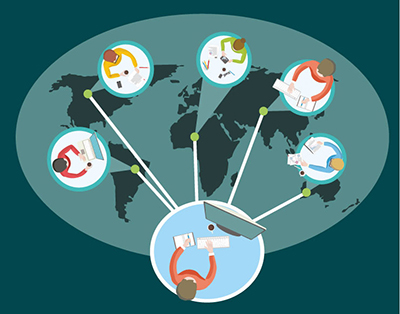If your workplace has been forced to go remote due to the recent coronavirus outbreak, you may be wondering how to communicate business changes with your workforce. Praveen Kanyadi, Cofounder and VP of Products at SpotCues, explains how managers must help employees communicate better during this period of isolation to ensure work maintains a steady flow and stress levels among employees remain low.
“From communication challenges to connectivity issues and process disruptions, remote working can cause disruption at the workplace, creating fear, anxiety, and chaos at different levels,” Kanyadi says. “First and foremost, leaders must identify all areas that would be impacted through remote working and come up with a communication plan for each of them.”
Kanyadi offers some suggestions regarding the areas that are either directly or indirectly impacted by employees working remotely:
- Impact on organizational processes—A lot of existing business processes may require field visits, paper processes, physical inspections, physical signatures, etc. With remote working, some of these processes may have to be reengineered or altered. It is important to have communication regarding the impact on these processes and articulation of how the new process would work.
- Impact on policies—Communication must be made around changes in policies, such as a work-from-home (WFH) policy, travel policy, etc.
- Tools, protocols for operational/team communication—Management should recommend tools for daily communication within teams/departments and provide information on how to access these tools, how to sign up, etc. This should also include protocols for schedule, availability, lunch breaks, etc.
- Impact on business—Make clear, transparent communication on how this outbreak is impacting the company’s operations, supply chain, revenues, etc., and what the strategic steps are that the organization is taking to address these challenges.
- Safety-related—Communicate information related to safety, especially for organizations that require some part of their workforce to operate from physical locations.
Next, Kanyadi says, it is important to identify the ideal top-down communication channel to communicate this information to employees.
“It’s important to pick a communication channel that enables direct communication from management to all employees,” adds Kanyadi. “This includes connecting with the frontline workforce directly. It also needs to enable two-way communication to collect feedback and data from the floor.”
While working remotely, there are a variety of applications and programs that allow employees to stay connected; however, this can cause employees to suffer from lower productivity as they try to navigate all the communication channels instead of being focused primarily on one or two chat apps.
How to Streamline Communication to Avoid App Fatigue
Streamlining work processes and communication channels is critical to help avoid app fatigue and a decrease in employee productivity.
“Increased digital communication could also lead to information overload, especially while using messaging channels,” Kanyadi says. It is critical to create some templates and protocols around communication. Kanyadi offers a few ways to streamline communication and increase productivity:
- Create a virtual work schedule that ensures the entire team’s availability. Encourage employees to maintain their availability status on their messenger profiles so everyone is aware of when employees are taking lunch breaks. Maintain a team calendar to make it easy to view team members’ schedules.
- Organize daily huddles on a fixed schedule via videoconferencing to simulate a real-world meeting.
- Pick an exclusive communication channel for critical or time-sensitive information.
- Create templates that encourage structured and brief updates at specified intervals.
- And finally, identify a moratorium period of a few hours during the day when employees are expected not to communicate unless it is absolutely important.
Additionally, it is important to have a fluid business continuity plan (BCP) that rethinks how employees are asked to work from home, says Kanyadi.
BCP for WFH
“Most business and organizational processes have well-established BCP plans, but the problem is that they are designed around the principles of delegation and escalation,” Kanyadi says. “The delegation is about being able to substitute the task to another person, while the escalation is about rules and protocols around decision-making when there is a deviation from the normal routine.”
“However, the recent COVID-19 crisis has brought to the fore another variable that most BCP plans haven’t accounted for, which is identifying the process, tools, and methodology when employees have to shift from the physical workplace to working remotely,” adds Kanyadi.
“Organizations are now realizing the importance of a fluid BCP that would seamlessly allow them to operate their business with minimal impact regardless of whether the employees are working from physical locations or remotely,” concludes Kanyadi.
After the crisis has passed, it’s worth reevaluating your BCP to see if WFH arrangements are necessary going forward. While these types of arrangements may not work for every organization or employee, for those that have the means to offer remote work, these companies will be able to survive the immediate crisis.

